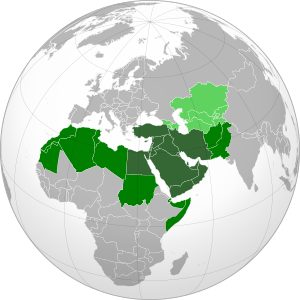Greater Middle East: Difference between revisions
m Reverted edits by 78.162.43.239 (talk) to last revision by Xqbot (HG) |
No edit summary |
||
| Line 9: | Line 9: | ||
|date=2004-03-03 |
|date=2004-03-03 |
||
|first=Safa |
|first=Safa |
||
|last=Haeri}}</ref> to englobe together various countries, pertaining to the [[Muslim world]], specifically [[Iran]], [[Turkey]], [[Afghanistan]] and [[Pakistan]].<ref>Ottaway, Marina & Carothers, Thomas (2004-03-29), [http://www.carnegieendowment.org/publications/index.cfm?fa=view&id=1480 The Greater Middle East Initiative: Off to a False Start], Policy Brief, ''Carnegie Endowment for International Peace'', 29, Pages 1-7</ref> Various [[Central Asian]] countries are sometimes also included. Some speakers may use the term to denote areas with significant Muslim majorities, but this usage is not universal. The Greater Middle East is sometimes referred to as "The New Middle East",<ref name="urukut">{{Cite web|url=http://www.globalresearch.ca/index.php?context=viewArticle&code=NAZ20061116&articleId=3882 |
|last=Haeri}}</ref> to englobe together various countries, pertaining to the [[Muslim world]], specifically [[Iran]], [[Turkey]], [[Afghanistan]] and [[Pakistan]].<ref>Ottaway, Marina & Carothers, Thomas (2004-03-29), [http://www.carnegieendowment.org/publications/index.cfm?fa=view&id=1480 The Greater Middle East Initiative: Off to a False Start], Policy Brief, ''Carnegie Endowment for International Peace'', 29, Pages 1-7</ref> Various [[Central Asian]] countries are sometimes also included. Some speakers may use the term to denote areas with significant Muslim majorities, but this usage is not universal. The term is meaningless in academics. The Greater Middle East is sometimes referred to as "The New Middle East",<ref name="urukut">{{Cite web|url=http://www.globalresearch.ca/index.php?context=viewArticle&code=NAZ20061116&articleId=3882 |
||
|accessdate=2008-08-21 |
|accessdate=2008-08-21 |
||
|title=Plans for Redrawing the Middle East: The Project for a “New Middle East” |
|title=Plans for Redrawing the Middle East: The Project for a “New Middle East” |
||
Revision as of 06:42, 25 November 2010

The Greater Middle East is a political term coined by the Bush administration[1] to englobe together various countries, pertaining to the Muslim world, specifically Iran, Turkey, Afghanistan and Pakistan.[2] Various Central Asian countries are sometimes also included. Some speakers may use the term to denote areas with significant Muslim majorities, but this usage is not universal. The term is meaningless in academics. The Greater Middle East is sometimes referred to as "The New Middle East",[3] or "The Great Middle East Project".[4][5]
This expanded term was introduced in the U.S. administration's preparatory work for the G8 summit of 2004[6] as part of a proposal for sweeping change in the way the West deals with the Middle East.
Former U.S. National Security Advisor Zbigniew Brzezinski, alluded to the modern Middle East as a control lever on an area he calls the Eurasian Balkans.[7] The Eurasian Balkans consists of the Caucasus (Georgia, the Republic of Azerbaijan, and Armenia) and Central Asia (Kazakhstan, Uzbekistan, Kyrgyzstan, Turkmenistan, Afghanistan, and Tajikistan) and Turkey. Turkey forms the northernmost part of the Middle East (though some of the country lies in the Caucasus).[8] Turkey's Western lands (i.e. the Eastern Thrace and the areas around Istanbul) are considered a part of the Southeastern Europe, and not the Middle East.
Criticism
The concept of a "Greater Middle East" that puts together different regions has been criticized by several people. According to the Al-Ahram Weekly, it is unclear whether widening the Middle East facilitates the control of its numerous conflicts. "The question is, however, whether there is such a thing as a Greater Middle East extending beyond the traditional geographical boundaries of the region. And, if so, what are the common features shared by the different countries now identified as parts of a body that would extend from Pakistan in the east to Morocco in the west? Take, for example, the call for the creation of an independent Arab state in Palestine. Does it follow that there should be a similar call for an independent Kurdish state or for an independent state in Kashmir? If all these countries are parts of one entity, should there not exist similar solutions for similar problems?"[9] Dominique de Villepin has said "One has also to avoid a uniform approach, as one can not treat the Maghreb with the same pattern as the Middle East or the Persian Gulf states, nor can one concentrate everything on the security issue. To be successful, our approach must be global, taking into consideration all the political, economic, social, cultural, educational aspects."[1]
See also
References
- ^ a b Haeri, Safa (3 March 2004). "Concocting a 'Greater Middle East' brew". Asia Times. Retrieved 21 August 2008.
- ^ Ottaway, Marina & Carothers, Thomas (2004-03-29), The Greater Middle East Initiative: Off to a False Start, Policy Brief, Carnegie Endowment for International Peace, 29, Pages 1-7
- ^ Nazemroaya, Mahdi Darius (18 November 2006). "Plans for Redrawing the Middle East: The Project for a "New Middle East"". Global Research. Retrieved 21 August 2008.
- ^ “Great Middle East Project” Conference by Prof. Dr. Mahir Kaynak and Ast.Prof. Dr. Emin Gürses in SAU
- ^ Turkish Emek Political Parties
- ^ Perthes, V., 2004, America's "Greater Middle East" and Europe: Key Issues for Dialogue, Middle East Policy, Volume XI, No.3, Pages 85-97.
- ^ Zbigniew Brzezinski, "The Grand Chessboard: American Primacy and Its Geo-strategic Imperatives" [page needed] Cited in (Nazemroaya, 2006).
- ^ Map of Greater Middle East
- ^ Mohamed Sid-Ahmed, On the Greater Middle East, Al-Ahram
External links
- Achcar, Gilbert (2004-04-04) Greater Middle East: The US plan, Le Monde Diplomatique
- Greater Middle East Partnership
